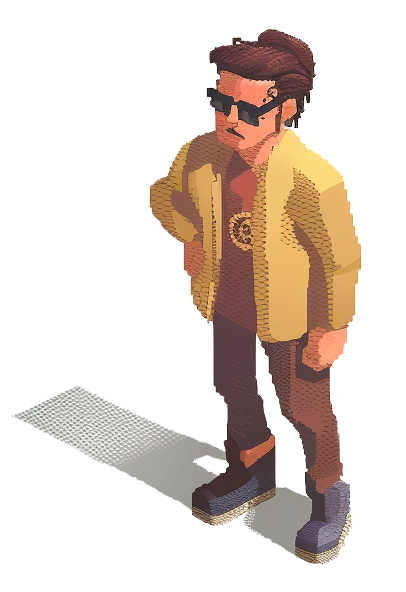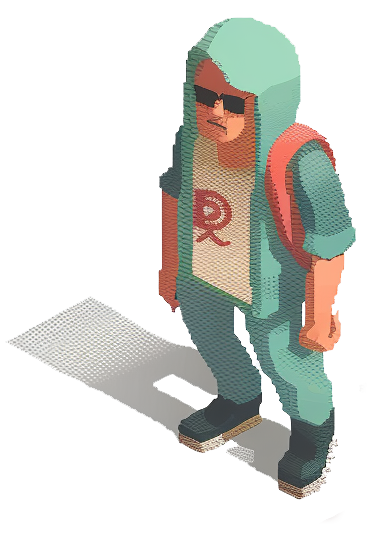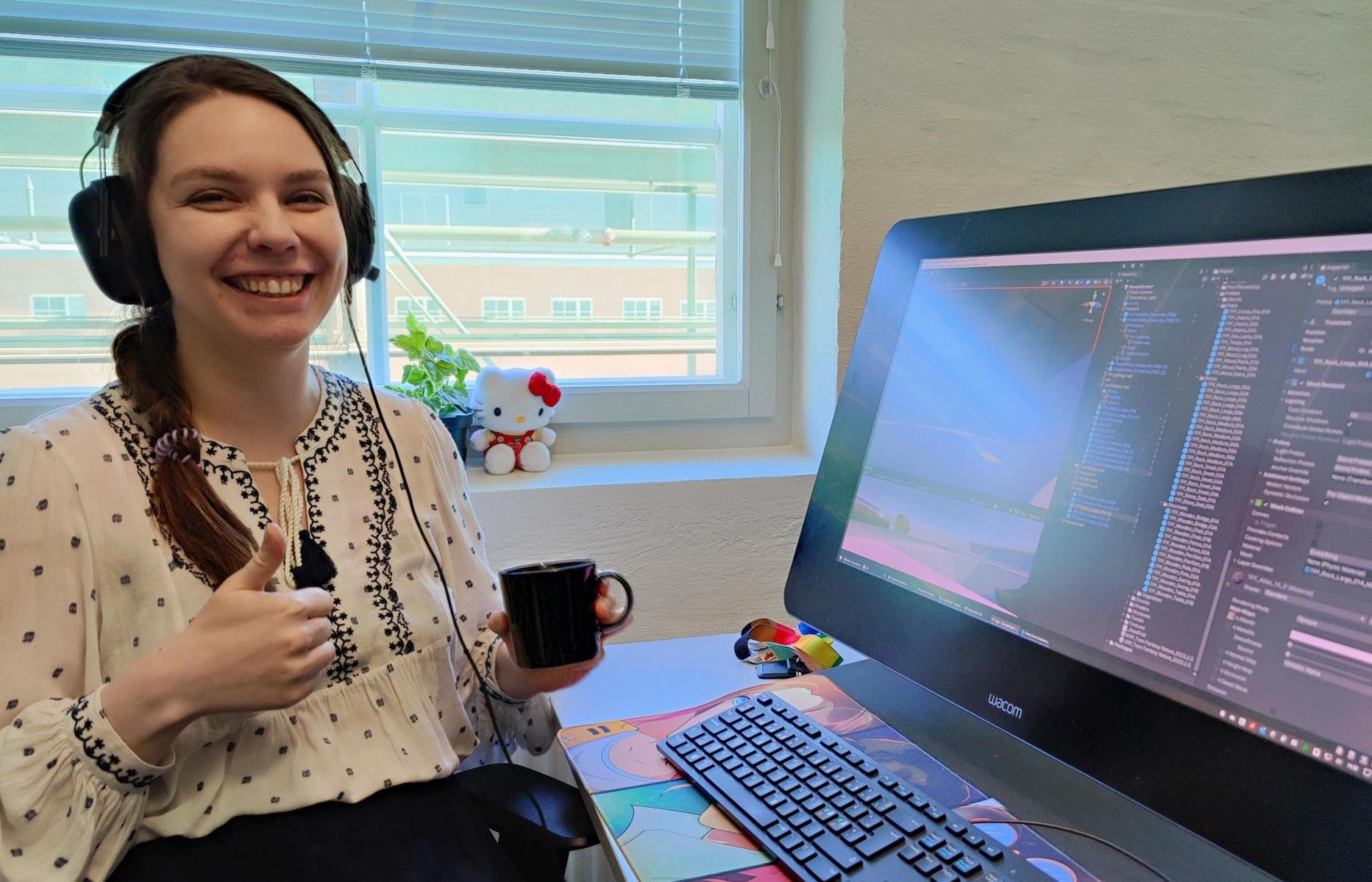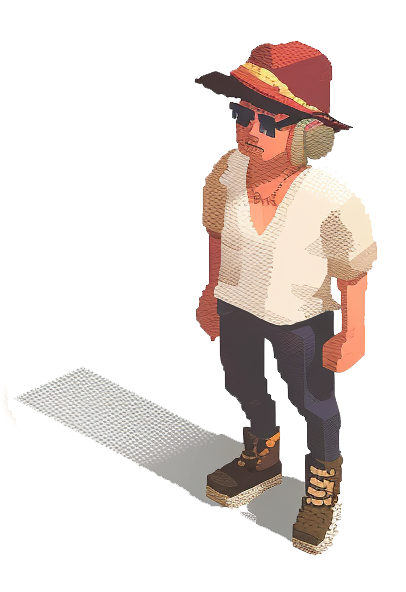In the ever-evolving world of XR and emerging technologies, new applications, devices and virtual worlds dazzle our collective imagination, however, the deeply human essence that drives innovation is often overshadowed. In this series of articles – Humans of XR – we take a step back from the cutting-edge advancements to focus on the individuals shaping the future of XR. Through conversations with professionals from various disciplines in the XR industry, we seek to uncover the personal journeys, inspirations, trepidations and hopes that drive the human experience behind the scenes.
The interview was conducted by Janset Shawash.
Today we are meeting with three trainees from Helsinki XR Center, Leevi Rantala, Kamil Řehoř and Niina Kahela, together with their team leader Emmi Isokirmo. We are making use of a rare afternoon lull in the spacious common room of the Center to sit down for some coffee, Finnish pulla pastries and an informal discussion about their personal experiences and thoughts on tech advancements in XR, as well as career paths and visions for the future of XR in Finland.
Here, in Part 1 of the interview we discuss key points such as how they arrived in the field, opinions on XR, AI and emergent technologies and personal experience of their use. In the upcoming Part 2, we will take a closer look at the realities of the XR industry in Finland and the prospects for the future generations of XR developers.

Leevi Rantala, a 3D generalist and a trainee at the HXRC.
Tell me a little about yourselves?
Leevi: I’m a 3D generalist. I first studied animation nearby at the Stadin AO – Helsinki Vocational College, then I went to work on TV productions. I came to Metropolia University of Applied Sciences to study 3D animation. I’ve been happy with my studies, and I ended up here at the Helsinki XR Center. At the moment, I’m working on a physiotherapeutic app, web service, and a gamified experience.
Kamil: I started as a hobbyist game developer, making games in 2014. Then I enrolled in Metropolia University in the Information and Communication Technologies programme, specializing in game development. Now I’m in my last year and have been training at the HXRC since the beginning of 2024. Here I work on a project that looks at the future use of 3D software and AI, and possible new XR development projects. I mostly focus on the new Omniverse applications made by NVIDIA, as well as my original specialty – Unreal Engine.

“At university I studied mathematics. But I kept on drawing and decided to go on and study 3D arts here in Metropolia. I really like sculpting, playing with textures, and artistic expression.”
“I started as a hobbyist game developer, making games in 2014. Then I enrolled in Metropolia University in the Information and Communication Technologies programme, specializing in game development.”
Niina: I have a strong 2D art background. I’ve always been drawing. At university I studied mathematics. But I kept drawing and decided to go on and study 3D arts here in Metropolia. I really like sculpting, playing with textures, and artistic expression. And now at the XR Center, I have been drawing a lot of 2D images for a visual novel style game about energy auditing.
Emmi: I am working as a 3D artist here. Right now, I’m leading the energy audit game which is part of a European Union funded project. It is almost finished and it’s looking really good. There are many interesting ideas in the projects we have, but when it comes to XR it’s hard to get companies to actually commit to do exciting things other than 360° images. That’s all there is. 360° images!
What innovations in the world of XR and emergent tech are you personally excited about?
Kamil: Personally, I am more interested in things that happen in the game context for XR. However, games are still somewhat rudimentary and have very heavy limitations, but I do still find it very exciting when game developers are able to find some way to leverage XR technology to create an experience that is unique, that is impossible to do without XR.
For the vast majority of people, there is still an extremely difficult barrier for entry. And these barriers are not just resource-based, they also include physical limitations, discomfort of use and motion sickness. I think it is good to keep in mind these sorts of limitations, because there is still a lot of unnecessary hype around certain concepts. Also, games are not so easy to get. I have a Steam library where I haven’t touched half the games. So, I wouldn’t really go out of my way to get a headset, unless I really, really wanted it.
As for the most exciting kind of experience, I think particular studios are very aware of the capability of XR, for example Valve’s Half-Life Alyx was very successful. Because Valve as a studio is very particular in the way that they do things. They don’t rely on games as a source of income anymore, so they make their games in a very careful and methodical way. And they tend to have the patience to wait for technology to arrive at a point where they think that they’re able to provide a particular experience. This allowed it to be very different from almost any other XR or VR game. And that sort of thinking when developing XR is very important, where you acknowledge the weaknesses and play to its strengths.
Niina: I have one thing that I’m really excited about – AR, because AR can be used a lot in learning. Everybody has a phone with them, so it doesn’t have to be a game. It’s just an application that you could bring to a forest, and it would show you 3D images about what vegetations would be there and what they could be used for. I like this kind of thing.
Kamil: It’s really important when you go to a real location, you see things for real for yourself. We want to still have that shred of human connection to reality.

“For the vast majority of people, there is still an extremely difficult barrier for entry into XR.”
“It’s really important that when you go to a real location, you see things for real for yourself. We want to still have that shred of human connection to reality.”
“I don’t really get excited about VR games that much. I think it’s too cumbersome.”
Leevi: For VR, the thing I’m most excited about is educational purposes. I am with Kamil, in that I don’t really get excited about VR games that much. I think it’s too cumbersome. In education, you can go to places, where it’s hard to normally go. And it’s really a lot better than reading a book or sitting on a chair.
A couple of my classmates and I are currently developing VR tools especially for education.
They cut costs and have great potential. You really remember stuff better when you do it with your own hands. Even though it’s just virtual.
One application we’re working on at the HXRC is a good example of how VR can enhance learning. In the application you’re supposed to change filters in a machine: remember to take the filters out of a package, put them into a bag, then put the bag into the package. There are certain things you have to do in a certain order.
And then, before you open the hatch you have to press this button and wait for a moment. And then check things with a flashlight. And then you’re supposed to check that the frame is okay with your finger, to actually put your finger there and do it.
And if this was just a third-person or a first-person game on a computer, you would not remember it. It would just be like click, click, click. But in VR you’re expected to do it yourself and know where you’re supposed to go, and this helps a lot with learning the tasks.

Niina Kahela, a 2D/ 3D artist and a trainee at the HXRC.
Emmi: I got into XR six or seven years ago when I joined a startup. Back then we had Oculus One and HTC Vive headsets. That was the best thing when we started. And I remember being really excited about the storytelling possibilities of VR. So, from that time one of my favourite VR games was I Expect You To Die.
Kamil: And I think the fundamental experience in games also shifts completely when you change to VR. Because it’s no longer a traditional first-person shooter game, where the skill is a very abstracted approximation of the actions you would do, using keyboard and mouse. When you have the capabilities of VR, you can be way more immersed in it. In a sort of full body sense.
This is often a mistake done by game studios. A terrible example would be Bethesda game studios, because they tend to make their games into VR versions of the same game and sell them at full price.
Horror games are one thing that makes good use of VR, where you want to be immersed. The point of a horror game is to make you scared. So being in VR makes you more scared. And it allows you to feel more “in there”.
Are you excited about any other emergent technologies, AI for example?
Kamil: I kind of hate the word AI, because it is a trend word. I would rather talk about large language models, LLMs because that’s the specific technology that all of these AI things tend to base themselves upon.
I took a course about AI, which was interesting, and it forced me to use the tools, but I still didn’t find the ones that would be useful to me. I found that the AI just did the same things that my own brain would do. So, I was just doing the same work twice in a weird way.
I also have other very particular opinions about AI because I think AI is very problematic.
Niina: I think AI is fine as long as you actually own the data. I have a problem with people taking other people’s data and hard work and then just using it for their own thing. Stealing is a bad thing with all the image generators. If you want to do this kind of image generation and you own the pictures you’re using to generate and teach the machine, then I’m totally fine with that. There has to be rules. I think AI is here to stay, but not win, we just co-exist, but it’s going to be costly. Your average person doesn’t really care if something is AI.
One ethically problematic thing about what AI offers, is that people can use it for really bad causes, like creating fake imagery about illegal things. This would be hard for humans to do on their own, but with AI you can make the computer do it for you. It’s scary how harmful it could be.
The European Union, the US and people in congresses have already started the process to make more rules. And of course, it’s a slow and hard process because the companies behind the technology are rich and they have a lot of money backing them up.

“AI as a conceptual technology might not be harmful in itself, but the fact is that we’re trying to rush towards this peak of the mountain, which is AGI – artificial general intelligence. No one still really knows why we want this thing. We believe it’s going to solve some problems for us, but we don’t actually know what the problem really is.“
Kamil: The process might be too slow. And I think the fundamental issue that is not often talked about, about AI and computation in general, is that computation as it is, on the industrial scale at which it is globally growing, is extremely harmful to the environment. There is too much power usage. Just for the creation of components, industrial manufacturing is extremely expensive. And we already know the amount of global geopolitical tension that is created. Looking at Taiwan, for example, the situation is extremely precarious.
AI as a conceptual technology might not be harmful in itself, but the fact is that we’re trying to rush towards this peak of the mountain, which is AGI – artificial general intelligence. No one really knows why we want this thing. We believe it’s going to solve some problems for us, but we don’t actually know what the problems really are. It’s just this general idea that it’s going to make everything better. But what really is this “everything”?
Is the cost of getting there too high? Because we have much bigger issues at the moment to solve than getting to the AGI point, and the process will probably destroy our chance of fixing all the other problems first, which can be solved with already existing technology. We are looking too far into the future with this idea of grandeur, these ambitious goals that just aren’t practical in any way for solving problems that could be solved already.
Follow us for Part 2, where we take a closer look at the realities of the XR industry in Finland for fresh graduates, and tips the coming generations of XR developers should keep in mind!
This interview has been edited and condensed for clarity.
Disclaimer: The opinions expressed in this interview are solely those of the interviewee(s) and do not reflect the views or positions of the Helsinki XR Center or its affiliates. This article is intended for informational purposes only and should not be taken as representative of the Helsinki XR Center’s official stance or policies.
Find more of our news in the News section.
Follow us on social media for more posts: Facebook | LinkedIn | Twitter | Instagram
